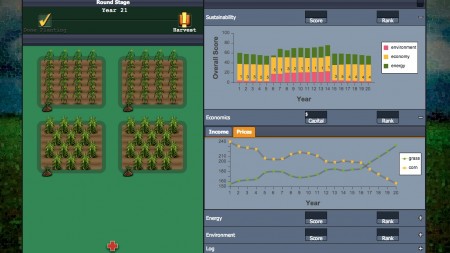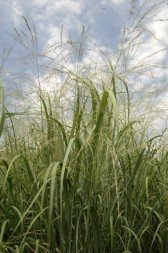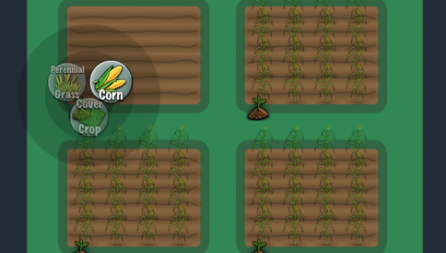
For many people, the allure of video games is unparalleled. These games provide hours upon hours of entertainment for dedicated players, many of whom are enticed by the prospect of hunting zombies and defeating alien empires. But of course, video games aren't just about fun these days. Since the late 1980s, video games have been used as teaching tools in the classroom, at home, and in other informal education settings. More recently, there has been a surge in the development of games that are being used not only to educate students, but also to enlighten scientists, policy makers, and others who hope to make use of the players' collective brain-power to help solve real-world problems. Stepping into this arena, a group of scientists and educators from the Midwest are trying to harness some of that time spent battling otherworldly marauders, and refocus it around answering questions related to an important agricultural puzzle: how to sustainably manage a biofuel farm.
Although there is general agreement that we should be growing crops that can be turned into biofuels, scientists and farmers are still debating the best way to proceed. There are questions about which crops to grow and how to raise them sustainably —as well as the larger question of what it means to be “sustainable.” Is a sustainable farm one with the best soil quality, or one that produces the most fuel, or one that yields enough income to support its farmers?

To answer some of these questions, scientists at the Wisconsin Institute for Discovery (WID) and at the University of Wisconsin-Madison have teamed up with ecologists and educators to create a video game. Their hope is that the game will lure players into channeling the kind of critical thinking used in entertainment based video games, which will in turn provide insights about the best way to grow biofuel crops.
In the game, whose working title is Fields of Fuel, players plant plots of energy-dense corn or more eco-friendly switchgrass — and then decide if they want to till the soil and whether or not to add fertilizer. After the virtual harvest, graphs display their income, energy production, and ecological impact, and compare those values to other players’ scores and to their own performance the previous year.
Fields of Fuel started as a student project in an interdisciplinary computer-science class taught by three WID scientists: Ben Shapiro, now a professor of engineering education at Tufts University; Michael Ferris, Professor of Computer Sciences at UW-Madison; and Steve Wangen, a postdoctoral researcher in UW-Madison’s department of Forestry and Wildlife Ecology.

When the Great Lakes Bioenergy Research Center realized the project’s potential, they contributed funding to keep it going. Rosemary Russ, a professor in the department of Curriculum and Instruction at UW-Madison, came on board to study players’ learning strategies and apply that knowledge to future iterations of the game. Fields of Fuel has been piloted in high-school classrooms and is slated to appear in courses at UW. During my conversation with the developers, they asked me to play it, too.
